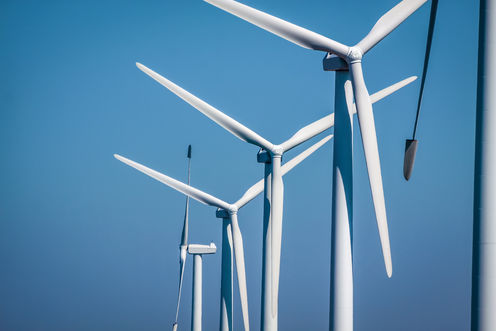
The Australian newspaper’s campaign against wind farms continued this morning with a page one story from the paper’s environment editor Graham Lloyd.
Lloyd writes about purportedly “groundbreaking” German research which, he infers, may provide a plausible basis for claims about wind turbines having direct effects on health.
Lloyd writes:
The results showed that humans could hear sounds of eight hertz, a whole octave lower than had been previously assumed, and that excitation of the primary auditory cortex could be detected down to this frequency.
A description of the project is here. The research never mentions wind turbines, only low-frequency noise, which is produced by many sources found in both nature and from a wide variety of mechanical sources.
The press release pitch, with its mentions of wind turbines, smells like a hook to a topical issue calculated to amplify attention to their work. (Note, this link to the press release was down at the time of publication.)
But these new findings are hardly “groundbreaking”. Earlier work found evidence of very similar auditory cortex stimulation from noise at 12Hz, slightly higher than the 8hz in this study.
In the study that excited Lloyd and the Australian’s sub-editors (the headline reads “Brains excited by wind turbines study”), auditory cortex stimulation at 8Hz (at pressure levels around the threshold of hearing) is meaningless in the context of wind turbine-generated infrasound, which is well below the threshold of perception.
Moreover, even fake stimuli can precipitate measurable activity in the brain. We know that both placebos (factors that increase expectations of positive outcomes) and nocebos (those which increase expectations of negative outcomes) can increase changes in cerebral metabolic rate when viewed via positron emission tomography (PET) scanning.
Expectations do not just affect people’s subjective experience of a stimulus (such as exposure to infrasound) but can actually produce measurable changes in brain activity which may or may not be markers of anything of clinical significance.
Fascinating work from Hungary and Germany on “electrosensitive” people (for example, those claiming to be made ill from exposure to mobile phones, wifi or other “stray” electricity) has shown that when such individuals are exposed to sham (fake) radiation from their feared source while thinking it is real, they experience symptoms. Correlates of these symptoms can be measured in the brain.
The Hungarian study exposed both people with “Idiophathic Environmental Intolerance (IEI) attributed to electromagnetic fields” and control subjects not reporting this condition to sham radiation. Those claiming IEI to electromagnetic frequency radiation both expected and experienced more symptoms.
In the German study, subjectively electrosensitive patients and gender-matched healthy controls were also exposed to sham mobile phone radiation and heat as a control condition. The subjects were not aware that the radiation was fake. Both before and during these exposures:
increased activations in anterior cingulate and insular cortex as well as fusiform gyrus were seen in the electrosensitive group compared to controls, while heat stimulation led to similar activations in both groups.
As the Hungarian researchers noted, electrosensitivity:
seems to be formed through a vicious circle of psychosocial factors, such as enhanced perception of risk and expectations, self-monitoring, somatisation and somatosensory amplification, causalization and misattribution.
In short, as the old saying goes, you can worry yourself sick. And those who spread fear arguably are an important part of this process.
Today’s Australian article complements Lloyd’s uncritical accounts of two recent studies about wind turbine noise. He wrote that:
Scientists in Japan measured brain function and reported last year that it showed the brains of Japanese wind turbine workers could not achieve a relaxed state.
As prominent wind industry science and research commentator Ketan Joshi has written:
[the study] doesn’t control for expectations, and it’s very likely that the subjects could perceive the sound = 20Hz at 92 dB(G), [at] the volume at which the synthesized noise was played, would annoy anyone.
Joshi compares such levels to the noise that would be experienced right inside a wind turbine nacelle, not hundreds of meters or several kilometers away, and notes that wind farm workers would never work inside nacelles when the turbines were turning.
Quoting an Iranian study, Lloyd continues:
In a similar vein, a study of 45 people … by Tehran University … said “despite all the good benefits of wind turbines, it can be stated that this technology has health risks for all those exposed to its sound.”
The study he referred to was of poor quality and Joshi has also mercilessly eviscerated its many problems, none of which Lloyd even hinted at.
Lloyd left messages for me to comment on the German research for his story. As his report notes, I did not respond. I have zero interest in obligingly playing into the Australian’s one-sided coverage. The paper has reported on a succession of trivial to terrible “studies” and published opinion pieces which are exalted by the tiny cells of anti-wind farm activists happy to embrace any fragment that furthers their cause.
No reporter from News has ever reported on any of my five recent studies on wind here, here, here, here, or here.
The University of Auckland’s Fiona Crichton who is arguably doing the world’s most advanced research on nocebo effects and wind farms has similarly never been reported.
The News agenda on wind energy is a travesty of good journalism.
Disclosure
In late 2012 Simon Chapman was remunerated by lawyers acting for Infigen energy for providing an expert report on psychogenic aspects of wind farm noise complaints for possible use in a Victorian Civil and Administrative Tribunal hearing. Expert witnesses have a general duty to courts, not to any party in proceedings, as set out here: http://www.fedcourt.gov.au/law-and-practice/practice-documents/practice-notes/cm7
